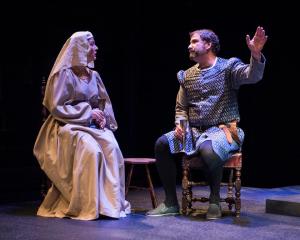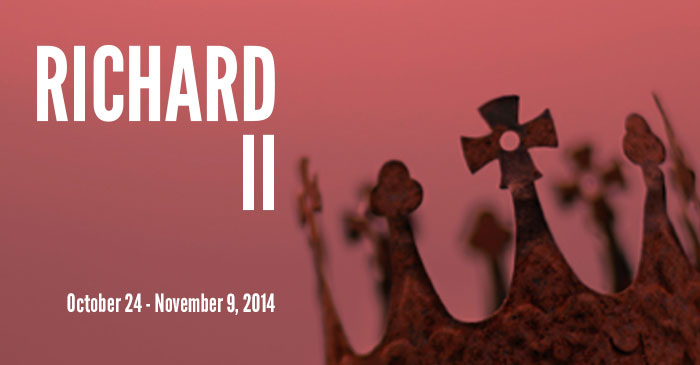What can we bequeath save our deposed bodies to the ground? Shakespearean essence in its purest sense; we are the stuff that dust is made of and our legacy is little more than our fragile mortal coil. An innovative new way of experiencing Shakespearean tragedy is striking up discourse on the stage of Chesapeake Shakespeare Company as the 2014 season progresses. The rarely performed Richard II is reinventing the meaning of tragedy under the skillful direction of Kevin J. Costa this fall; an introspective examination of self-knowledge in relation to tragedy.
Back to basics and true to the period Scenic and Lighting Designer Daniel O’Brien allows the characters and the story to speak for themselves. No fancy adaptations to another time and place; just the honest extrapolation of basic lighting and even more simplistic scenery to allow the essence of the show’s humanity and tragedy converge upon the stage in its rawest form. Costume Designer Heather C. Jackson has kept true to the period’s nature with the regal yet subdued patterns inlaid into the doublets of the men and the long dresses of the women. The color and patterns used in Jackson’s design reflect elegance and royalty without overwhelming the actors in them.

Director Kevin J. Costa takes an underrated historical tragedy within the Bard’s canon and brings it to Baltimore for the first time in nearly 200 years. Previously performed in 1830, Costa’s mounting of the deceptively dreary story proves his worth as a visionary genius to the stage. Taking a story as heavy with background history as Richard II and delivering it in such a way that it compels the audience to be invested in the characters’ stories is impressive and Costa delivers nothing short of that. The moments between Bolingbroke and Richard, though few and far between, are loaded with biting tension that could detonate the silence of the room into catastrophic din at any moment. His approach to the dialogue heavy scenes allows for the characters to really address the baser issues of Shakespeare’s work. The production ultimately delivers a divinely profound learning lesson and is beyond just the tragic demise of the crowned king of England.
Fight Choreographer James Jager deserves mentioning for his sharp precision in the show’s only fight, which happens in the penultimate scene of the performance. Though swords aren’t clashing, the interaction between those caught in the skirmish is executed so tightly that it almost jarring in its violence. Jager creates a shocking reality in the show’s only brawl; a striking turning of events in the plot up to that point.
As is a signature on any Chesapeake Shakespeare Company work, the Bard’s vernacular is made readily accessible to all audience members regardless of their familiarity or understanding of Shakespearean language. The approach to delivering clear emotions, deliberate gestures, and concepts filled with understanding is second to none when it comes to the essence and even the finer nuances of the characters’ stories. The company is still providing a great deal of intimacy to the audience throughout the performance; Richard’s final speech in prison addressed directly to the audience rather than internalized to the ground.

A harrowing moment comes delivered with piety and ferocious temper from Frank B. Moorman in his role of Bishop of Carlisle. Doubling as John of Gaunt the Duke of Lancaster, Moorman goes on an equally charged tirade early in the production as well; both being memorable for the burning fury that drives these monologues. Though their subject matter be different, their passions are alike in the spirit that they burn. Moorman delivers an impressive physicality as the Duke of Lancaster, his trembling hand and unsteady gait a vast and opposing difference to the surefooted Bishop. His versatility in these two minor roles shows the depth of his performance capabilities.

Even in Shakespeare’s tragedy there is comedy to be had. While it doesn’t escalate until the second act, the Duke of York (Michael P. Sullivan) the Duchess (Karina Hilleard) and their son the Duke of Aumerle (Sèamus Miller) come to a rousing head in a scene of chase played out first in the Duke’s home and later at the foot of Bolingbroke. Hilleard’s maternal badgering and pleas are hilarious as she combats first her husband and later Bolingbroke on behalf of her son. Miller, who expresses a great deal of painstaking woe once accused of unsavory indiscretions, is a sturdy, albeit reserved, actor who delivers on cue in the moment.
Sullivan, as the spastic and explosive Edmund Langley Duke of York delivers perhaps the funniest of monologues and later dialogue exchange in the performance. The angrier he becomes, the harder he strikes out for his purpose, the more the audience roars with laughter. Despite this comic outburst, Sullivan does an equally exceptional job of leveling his characters severity to the quick throughout the rest of the performance
Playing doting Queen to the king is the good lady Molly Moores. Her scenes, though brief, are passionate, even when she is sullen and forlorn over the potential loss of her husband. The tender interactions between Moores and Richard denote the depth of their relationship. Moores carries her character’s emotions in her voice, using pitch control to drive out the more intense moments of loss and sorrow when she comes upon them.

If there be a villain, his name doth be Bolingbroke (Patrick Kilpatrick.) Cruel and ruthless, though not without compassion, Kilpatrick delivers a bristling character that crawls under the skin and explodes from the inside. Treacherous but earnest, warped but noble to his own cause, Kilpatrick’s portrayal of Henry Bolingbroke leaves nothing to be desired; a completely satisfying interpretation of an antagonist if ever there was one. His scenes with Richard are driven hard with tension and defiance; particularly at the top of the second act when both his hand and Richard’s hold the crown of England between them. That moment alone is a fat pay off to all who have watched the show up to that point.
As for the title king, Jonas David Grey delivers a phenomenal performance in the role. With striking calm, Grey’s stage presence alone is both enticing and intimidating. To watch one man have such command over the way his character moves, thinks, speaks, and acts; and for it all to be visible in just a few uttered words is truly commendable. The raw reality that Grey unearths in Richard speaks to the quote delivered in the king’s final speech from prison. Grey has allowed Richard to find peace by evolving him through the performance. A remarkable interpretation of the character, Grey showcases a fully working knowledge of Shakespeare’s Richard II. There are moments in his performance that deliver chills; moments that draw forth tears; and moments for which there are simply no words.

Do not miss the rare opportunity to see one Shakespeare’s lesser produced works. It took nearly 200 years to have this show remounted in Baltimore, and one certainly does not wish to wait another 200 when Chesapeake Shakespeare has dramatic genius unfolding right upon their very stage in regards to Richard II.
Running Time: Approximately 2 hours and 35 minutes with one intermission
Richard II plays through November 9, 2014 at Chesapeake Shakespeare Company— 7 S. Calvert Street in Baltimore, MD. For tickets call the box office at 410-244-8570 or purchase them online.
Click here to read the TheatreBloom exclusive interview with Jonas David Grey on playing Richard II and Edward II in the same season.

